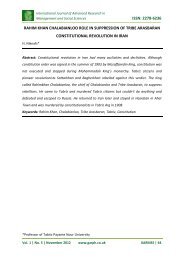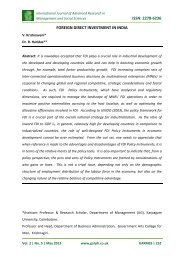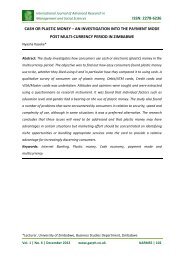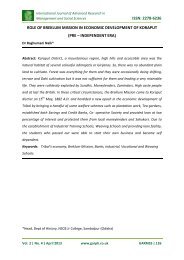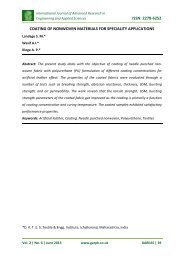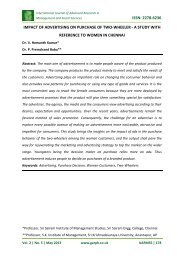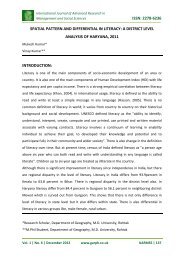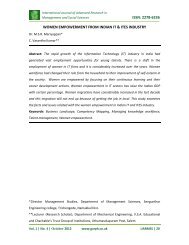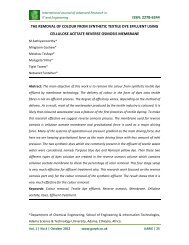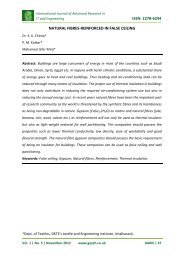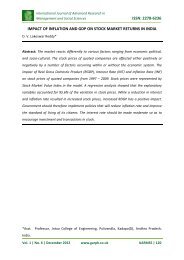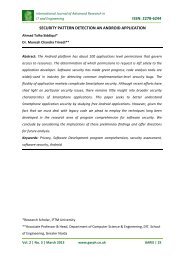ISSN: 2278-6236 NewGenLib: OPEN SOURCE ... - Garph.co.uk
ISSN: 2278-6236 NewGenLib: OPEN SOURCE ... - Garph.co.uk
ISSN: 2278-6236 NewGenLib: OPEN SOURCE ... - Garph.co.uk
Create successful ePaper yourself
Turn your PDF publications into a flip-book with our unique Google optimized e-Paper software.
Kirti Singh*<br />
International Journal of Advanced Research in<br />
Management and Social Sciences <strong>ISSN</strong>: <strong>2278</strong>-<strong>6236</strong><br />
<strong>NewGenLib</strong>: <strong>OPEN</strong> <strong>SOURCE</strong> SOFTWARE’S IN INDIAN LIBRARIES<br />
Abstract: Open system is not known for being easy to use. Usability <strong>co</strong>uld be one of the most<br />
effective changes to make in open source system. NenGenLib is an integrated library<br />
management system developed by various solutions pvt.ltd. Domain expertise is provided by<br />
Kesavan .In this paper highlights the features of <strong>NewGenLib</strong> open source software, the first<br />
of its kind developed in India. Discuss the issues like History of OSS, their Definition, selection<br />
criteria of library automation software; factors pushing the use of OSS; the features of<br />
<strong>NewGenLib</strong> open source software and evaluation of these in the line of advantages and<br />
disadvantages.<br />
Keywords: <strong>NewGenLib</strong>, Library automation, Open Source, Software<br />
*Librarian, SSDWomens Institute of Technology, Bathinda<br />
Vol. 1 | No. 6 | December 2012 www.garph.<strong>co</strong>.<strong>uk</strong> IJARMSS | 173
International Journal of Advanced Research in<br />
Management and Social Sciences <strong>ISSN</strong>: <strong>2278</strong>-<strong>6236</strong><br />
1. INTRODUCTION:<br />
The free software movement was launched in 1983. In 1998, a group of individuals<br />
advocated that the term free software be replaced by open source software (OSS) as an<br />
expression which is less ambiguous and more <strong>co</strong>mfortable for the <strong>co</strong>rporate world. Software<br />
developers may want to publish their software with an open source license, so that anybody<br />
may also develop the same software or understand how it works. Open source software<br />
generally allows anyone to make a new version of the software, port it to new operating<br />
systems and processor architectures, share it with others or market it. The aim of open<br />
source is to let the product be more understandable, modifiable, duplicatable, reliable or<br />
simply accessible, while it is still marketable.<br />
Open Source definition, notably, presents an open source philosophy, and further defines a<br />
boundary on the usage, modification and redistribution of open source software. Software<br />
licenses grant rights to users which would otherwise be prohibited by <strong>co</strong>pyright. These<br />
include rights on usage, modification and redistribution. Several open source software<br />
licenses have qualified within the boundary of the Open Source Definition. The most<br />
prominent example is the popular GNU General Public License. While open source presents<br />
a way to broadly make the sources of a product publicly accessible, the open source licenses<br />
allow the authors to fine tune such access.<br />
2. DEFINITION OF OSS:<br />
Open source means several things:<br />
1. Open source software is typically created and maintained by developers crossing<br />
institutional and national boundaries, <strong>co</strong>llaborating by using internet based<br />
<strong>co</strong>mmunications and development tools.<br />
2. Products are typically a certain kind of "free", often through a license that specifies<br />
that applications and source <strong>co</strong>de (the programming instructions written to create<br />
the applications) are free to use, modify, and redistribute as long as all uses,<br />
modifications, and redistributions are similarly licensed.<br />
3. Successful applications tend to be developed more quickly and with better<br />
responsiveness to the needs of users who can readily use and evaluate open source<br />
applications because they are free.<br />
Vol. 1 | No. 6 | December 2012 www.garph.<strong>co</strong>.<strong>uk</strong> IJARMSS | 174
International Journal of Advanced Research in<br />
Management and Social Sciences <strong>ISSN</strong>: <strong>2278</strong>-<strong>6236</strong><br />
4. Quality, not profit, drives open source developers who take personal pride in seeing<br />
their working solutions adopted.<br />
5. Intellectual property rights to open source software belong to everyone who helps<br />
build it or simply uses it, not just the vendor or institution who created or sold the<br />
software.<br />
The Open Source Initiative (OSI) identified ten criteria for a software product to be called<br />
open source. The OSI certifies a software license as an ‘OSI Certified License ‘on the basis of<br />
the following ‘Ten Commandments:<br />
1. Free Redistribution<br />
The license shall not restrict any party from selling or giving away the software as a<br />
<strong>co</strong>mponent of an aggregate software distribution <strong>co</strong>ntaining programs from Several<br />
different sources. The license shall not require a royalty or other fee for such sale.<br />
2. Source Code<br />
The program must include source <strong>co</strong>de, and must allow distribution in source <strong>co</strong>de as well<br />
as <strong>co</strong>mpiled form. Where some form of a product is not distributed with source <strong>co</strong>de, there<br />
must be a well-publicized means of obtaining the source <strong>co</strong>de for no more than a<br />
reasonable reproduction <strong>co</strong>st preferably, downloading via the Internet without charge. The<br />
source <strong>co</strong>de must be the preferred form in which a programmer would modify the program.<br />
Deliberately obfuscated source <strong>co</strong>de is not allowed. Intermediate forms such as the output<br />
of a preprocessor or translator are not allowed.<br />
3. Derived Works<br />
The license must allow modifications and derived works, and must allow them to be<br />
distributed under the same terms as the license of the original software.<br />
4. Integrity of the Author's Source Code<br />
The license may restrict source-<strong>co</strong>de from being distributed in modified form only if the<br />
license allows the distribution of "patch files" with the source <strong>co</strong>de for the purpose of<br />
modifying the program at build time. The license must explicitly permit distribution of<br />
software built from modified source <strong>co</strong>de. The license may require derived works to carry a<br />
different name or version number from the original software.<br />
Source <strong>co</strong>de:<br />
1. No Discrimination Against Persons or Groups<br />
Vol. 1 | No. 6 | December 2012 www.garph.<strong>co</strong>.<strong>uk</strong> IJARMSS | 175
International Journal of Advanced Research in<br />
Management and Social Sciences <strong>ISSN</strong>: <strong>2278</strong>-<strong>6236</strong><br />
The license must not discriminate against any person or group of persons.<br />
2. No Discrimination Against Fields of Endeavor<br />
The license must not restrict anyone from making use of the program in a specific field of<br />
endeavor. For example, it may not restrict the program from being used in a business, or<br />
from being used for genetic research.<br />
3. Distribution of License<br />
The rights attached to the program must apply to all to whom the program is redistributed<br />
without the need for execution of an additional license by those parties.<br />
4. License Must Not Be Specific to a Product<br />
The rights attached to the program must not depend on the program's being part of a<br />
particular software distribution. If the program is extracted from that distribution and used<br />
or distributed within the terms of the program's license, all parties to whom the program is<br />
redistributed should have the same rights as those that are granted in <strong>co</strong>njunction with the<br />
original software distribution.<br />
5. License Must Not Restrict Other Software<br />
The license must not place restrictions on other software that is distributed along with the<br />
licensed software. For example, the license must not insist that all other programs<br />
distributed on the same medium must be open-source software.<br />
6. License Must Be Technology-Neutral<br />
No provision of the license may be predicated on any individual technology or style of<br />
interface.<br />
3. FACTORS PUSHING THE USE OF OSS<br />
Ac<strong>co</strong>rding to Chudnov [2] there are three factors pushing the use of OSS in libraries:<br />
A OSS licenses allow libraries to cut budget on software and use it to other issues needing<br />
more funds.<br />
B OSS product is not locked into a single vendor. Thus even if a library buys an open source<br />
system from one vendor, it might choose to buy technical support from another <strong>co</strong>mpany or<br />
get it from in- house experts.<br />
C The entire library <strong>co</strong>mmunity might share the responsibility of solving information systems<br />
accessibility issues.<br />
Vol. 1 | No. 6 | December 2012 www.garph.<strong>co</strong>.<strong>uk</strong> IJARMSS | 176
International Journal of Advanced Research in<br />
Management and Social Sciences <strong>ISSN</strong>: <strong>2278</strong>-<strong>6236</strong><br />
4. OSS IN LIBRARY & INFORMATION MANAGEMENT<br />
Open source software has had an increasingly high profile in the library and information<br />
management profession since 1999. A September 1999 meeting of 80 senior American<br />
academic library managers created three “keystone principles” to set a foundation for<br />
future developments of library services. One of these, “libraries are responsible for creating<br />
innovative information systems for the dissemination and preservation of information and<br />
new knowledge regardless of format” had an action item to “create interoperability in the<br />
systems they develop and create open source software for the access, dissemination, and<br />
management of information”. Members of the profession have <strong>co</strong>ntinued to have a high<br />
level of interest in OOS software, with more than 200 articles and <strong>co</strong>nference papers<br />
published in the last 4 years to describe specific projects. The oss4lib portal<br />
(http://www.oss4lib.org), originally set up in 1999, listed over 1090 library-related projects<br />
in Nov 2008.<br />
5. GENISIS OF <strong>NewGenLib</strong><br />
<strong>NewGenLib</strong>, stand for New Generation Library is an Integrated library automation system<br />
developed in India, has recently joined the open source <strong>co</strong>mmunity. This product was<br />
introduced in 2003, primarily intended for libraries in the developing world. It has been<br />
adopted by about 122 libraries, primarily in India, but with some sites in Syria, Sudan, and<br />
Cambodia. Two groups <strong>co</strong>llaborate in the development and support of <strong>NewGenLib</strong>. Kesavan<br />
Institute of Information and Knowledge Management (KIIKM) is a non-profit professional<br />
trust that spearheads the project. This organization describes its primary goal as “acting as<br />
an independent, non-governmental centre for the study, training and advocacy in<br />
information and knowledge management.” The key activities and funding for the trust relate<br />
primarily to <strong>NewGenLib</strong>, the development of a textbook on library automation, and on the<br />
creation of e-learning modules on library automation. Versus Solutions, a small software<br />
development <strong>co</strong>mpany performs the technical development of the software.<br />
Both organizations are located in Hyderabad, India.<br />
The software has been distributed under the traditional <strong>co</strong>mmercial license model since<br />
2003. In January 2008, the decision was made to offer the system as open source software<br />
under the GNU GPL (General Public License). Ac<strong>co</strong>rding to L.J. Haravu, one of the three<br />
principals of KIIKM, the move to an open source model would result in wider adoption of<br />
Vol. 1 | No. 6 | December 2012 www.garph.<strong>co</strong>.<strong>uk</strong> IJARMSS | 177
International Journal of Advanced Research in<br />
Management and Social Sciences <strong>ISSN</strong>: <strong>2278</strong>-<strong>6236</strong><br />
the software. The organizations involved would move from a license-based business model<br />
to one based on service.<br />
A new <strong>co</strong>mpany was formed, Versus IT Services Pvt. Ltd., to provide service and support for<br />
the product as it moves into the open source realm. The relationship of this new <strong>co</strong>mpany<br />
to <strong>NewGenLib</strong> closely resembles that of Liblime to Koha and Equinox Software to Evergreen.<br />
<strong>NewGenLib</strong>, as an ILS tailored for libraries in developing <strong>co</strong>untries, may not necessarily be of<br />
direct interest to libraries in our region. It does, however, show that the open source<br />
approach for library automation system has also made some advances internationally.<br />
<strong>NewGenLib</strong> version 1.0 was released in March 2005. On 9 January 2008, <strong>NewGenLib</strong> was<br />
declared Open Source Software under GNU GPL Licence by Verus Solutions.[7] Currently<br />
<strong>NewGenLib</strong> 3.0.3 U2 is the latest version running. It is estimated that 2,500 libraries across<br />
58 <strong>co</strong>untries are using <strong>NewGenLib</strong> as their Primary integrated library management system.<br />
I think it is the only one <strong>co</strong>mmunity from India who gives a guaranteed release of new<br />
features and bug fixes for every 45 days.<br />
6. SALIENT FEATURES OF <strong>NewGenLib</strong> SOFTWARE<br />
1 Functional modules are <strong>co</strong>mpletely web based. Uses Java Web Start Technology<br />
2 Compatibility - Complies with international metadata and interoperability standards:<br />
MARC- 21, MARC-XML, z39.50, SRU/W, OAI-PMH<br />
3 Uses chiefly open source <strong>co</strong>mponents<br />
4 Scalable, manageable and efficient<br />
5 OS independent - Windows and Linux flavors’ available<br />
6 z39.50 Client for federated searching<br />
7 Internationalized application (I18N)<br />
8 Uni<strong>co</strong>de 3.0 <strong>co</strong>mplaint<br />
9 Arabic version available<br />
10 Easily extensible to support other languages<br />
11 Data entry, storage, retrieval in any (Uni<strong>co</strong>de 3.0) language<br />
12 RFID integration<br />
13 Networking – Hierarchical and Distributed networks<br />
14 Automated email/instant messaging integrated into different functions of the software<br />
15 Form letters are <strong>co</strong>nfigurable and use XML-based Open Office templates<br />
Vol. 1 | No. 6 | December 2012 www.garph.<strong>co</strong>.<strong>uk</strong> IJARMSS | 178
International Journal of Advanced Research in<br />
Management and Social Sciences <strong>ISSN</strong>: <strong>2278</strong>-<strong>6236</strong><br />
16 Extensive use of set up parameters enabling easy <strong>co</strong>nfiguration of the software to suit<br />
specific needs, e.g., in defining patron privileges<br />
17 Supports multi-user and multiple security levels<br />
18 Allows digital attachments to metadata<br />
7. ADVANTAGES OF <strong>NewGenLib</strong><br />
The advantages of <strong>NewGenLib</strong> open source may be perceived as follows in the light of the<br />
advantages of open source software as pointed out by Richard W Boss<br />
1 Ability to tailor to fit local needs: The availability of the source <strong>co</strong>de means that a user<br />
can modify and enhance the software to more closely fit its own needs. Unlike with<br />
proprietary products, the user, not a vendor, sets the development priorities. The user is<br />
also able to set its own priorities for bug fixes.<br />
2 No restriction on use: unlike <strong>co</strong>mmercial software, there are any <strong>co</strong>ntractual restrictions<br />
on how the software is used. While some developers use the GNU General Public License<br />
that assures users that they have the right to distribution and those to whom they distribute<br />
also have the right to modify and distribute, other developers merely declare that their<br />
software is in the public domain. A subsequent user may, therefore, decide to protect the<br />
enhancements that it makes by <strong>co</strong>pyrighting them.<br />
3 Low <strong>co</strong>st: There is no charge for the software; therefore, the capital outlay required by<br />
<strong>co</strong>mmercial software is avoided. The major <strong>co</strong>sts are ongoing development and<br />
maintenance. If the number of users is large, and they share their efforts, each user’s <strong>co</strong>st is<br />
reduced. However, if the number is small or a user does a lot of tailoring to fit unique local<br />
needs that are not shared by other users, the <strong>co</strong>st can escalate.<br />
8. DISADVANTAGES OF <strong>NewGenLib</strong><br />
However I pointed out some disadvantage of this type of open source software. There are<br />
lack of <strong>co</strong>ordination, inadequate training and technical support, lack of participation, lack of<br />
guarantees and remedies, scalability and speed etc. However, the developer of the<br />
<strong>NewGenLib</strong> open source is expected to solve these disadvantages. The of open source<br />
software may not offer the liability and speed of proprietary software because the easy-touse<br />
and general-purpose programming languages used are not very scalable and are slower<br />
than other languages. But <strong>NewGenLib</strong> open source has over<strong>co</strong>me this problem. On the<br />
Vol. 1 | No. 6 | December 2012 www.garph.<strong>co</strong>.<strong>uk</strong> IJARMSS | 179
International Journal of Advanced Research in<br />
Management and Social Sciences <strong>ISSN</strong>: <strong>2278</strong>-<strong>6236</strong><br />
other hand the Versus Solution Pvt. Ltd organizes workshop and training programmers for<br />
appropriate support.<br />
9. TYPE OF LIBRARIES<br />
<strong>NewGenLib</strong> can be used for any type of library. In fact it is used by all types of libraries.This<br />
is because NGL is targeted towards public libraries. The type of libraries in which <strong>NewGenLib</strong><br />
can be used are:<br />
A University libraries<br />
B College/School libraries<br />
C Public libraries<br />
D Libraries in Research Institutes<br />
E Libraries in Offices/Corporate<br />
10 . MIGRATING TO <strong>NewGenLib</strong><br />
1 Implement in your library to automate the various services.<br />
2 You can get all your data (in any format i.e.-Excel, CDS/ISIS, Internal-LMS whatever)<br />
imported into <strong>NewGenLib</strong> database. And ready to use.<br />
3 Get all the good features of <strong>NewGenLib</strong> database<br />
4 Get all new updates, upgrades, versions, and bug fixes of <strong>NewGenLib</strong> free-of-<strong>co</strong>st for life-<br />
time. <strong>NewGenLib</strong> guarantees life-time open source releases.<br />
11. CONCLUSION<br />
OSS has much potential for libraries and information centers, and there are a number of<br />
projects, including Greenstone, Koha, NewGenlib and Dspace, etc. that demonstrate its<br />
viability in this <strong>co</strong>ntext. It gives library staff an option to be actively involved in development<br />
projects, and this involvement can take many forms, such as reporting bugs, suggesting<br />
enhancements, and testing new versions. Organization adopting OSS will need to provide<br />
their staff with additional development and training to enable them to take on these new<br />
roles effectively, and will need to have a long-term <strong>co</strong>mmitment to the projects. Systems<br />
librarians and library managers should watch this trend for future developments.<br />
REFERENCES<br />
1. General Public License. Wikipedia. Accessed on 23/11/2011<br />
from
International Journal of Advanced Research in<br />
Management and Social Sciences <strong>ISSN</strong>: <strong>2278</strong>-<strong>6236</strong><br />
2. Chudnov, Dan (1999). Open Source Library Systems: Getting Started. Accessed on<br />
11-10-2011 from





